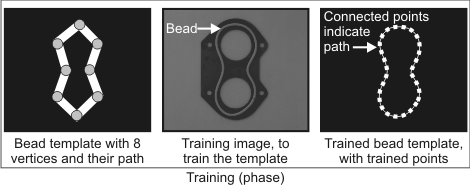Basic concepts for the MIL Bead module
The basic concepts and vocabulary conventions for the MIL Bead module are:
-
Bead. A strip of malleable material, such as glue or lead, typically used to bond objects together.
-
Bead template. A reusable model of a bead.
-
Edge. A curve that delineates a boundary, which can be established from intensity transitions in an image.
-
Gap. Consecutive measured points that were expected but not found.
-
Measured bead. A bead in a target image that MIL verifies.
-
Measured point. A trained point's corresponding point found (or expected) on a measured bead.
-
Path. The continuous sequence of positions that the bead follows.
-
Point. A positional element along a bead.
-
Search box. The region in the image in which to extract a point along the bead. The portion of the bead, corresponding to the search box of a point, can be referred to as a slice.
-
Stripe. A bead consisting of two edges; the distance between the edges is the bead's width.
-
Target image. The image in which to measure and validate beads during the verification phase.
-
Trained bead. A template that has been trained (contains the trained points), which allows you to use it for the verification of a bead.
-
Trained points. Points contained in a template, generated by the training phase, and used for the verification of a bead. Each trained point is associated with the width and height of the bead slice from which it was extracted (search box).
-
Training (phase). The operation that uses all training specifications to generate the trained bead template(s).

-
Training image. An ideal image of beads, which you can use during the training phase to train the templates and establish their trained points.
-
Verification (phase). The operation that analyzes beads in the target image and validates whether they conform to the specified bead template.

-
Vertices. Positional points added to a bead template to define its path.